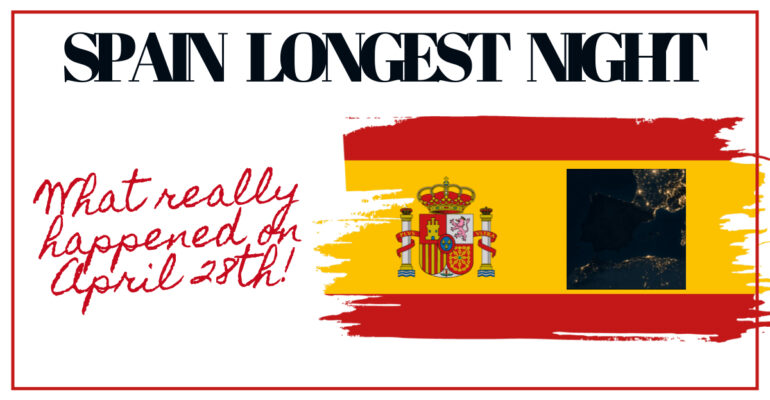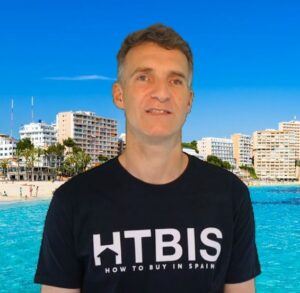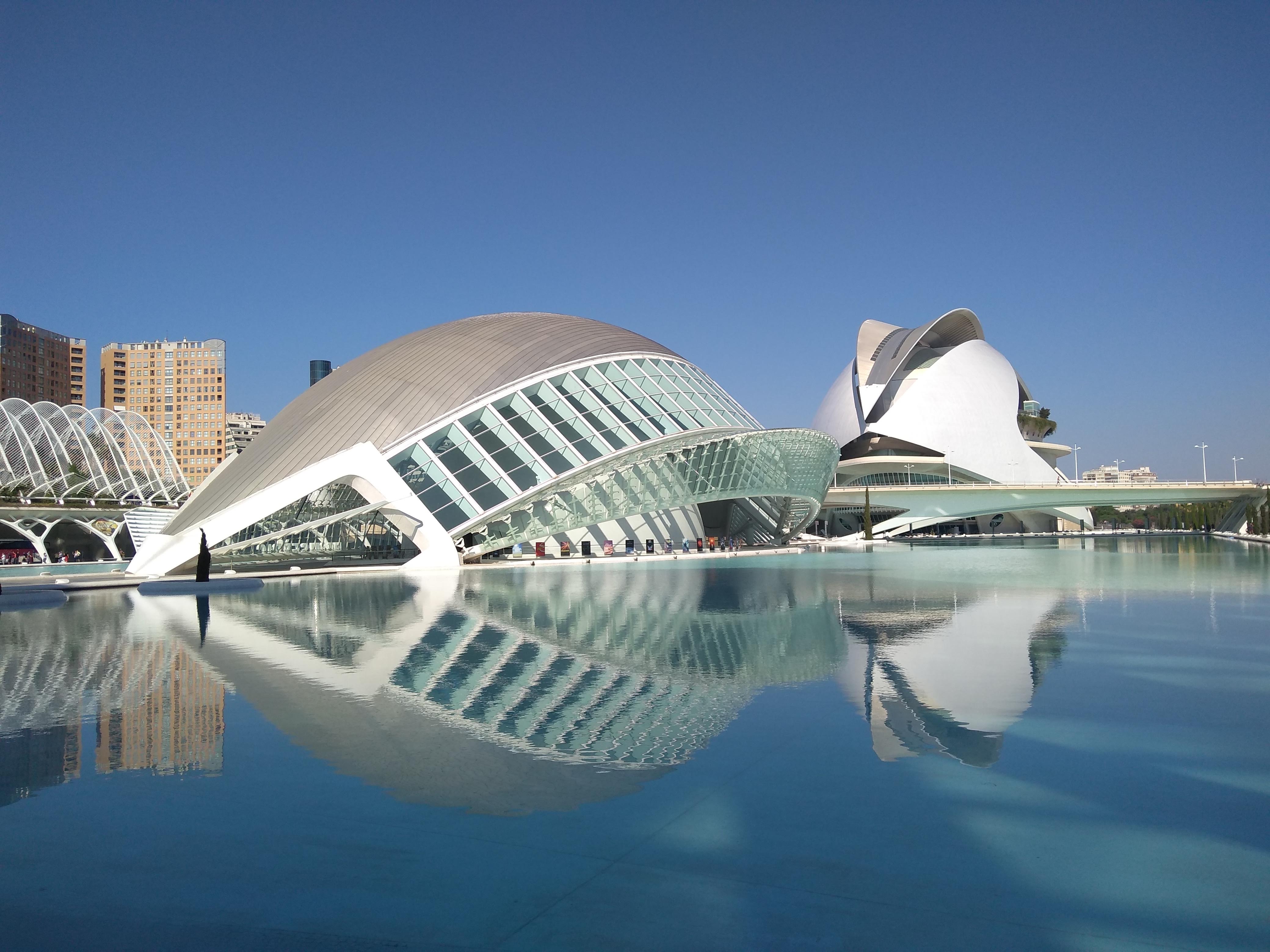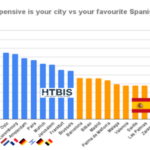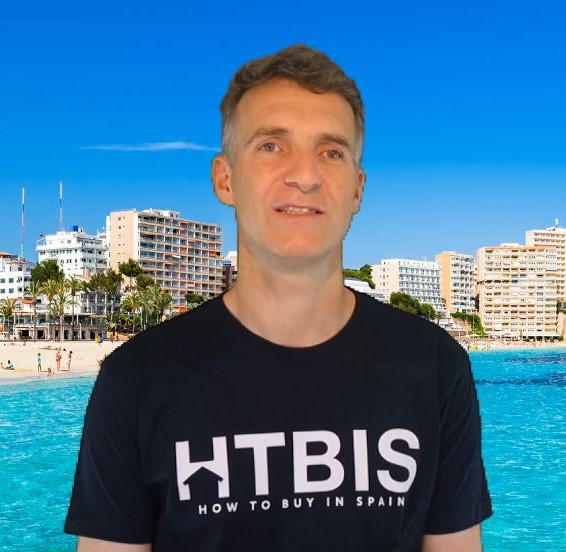 Reading time 6 minutes. Use our table of content for a quick read.
Reading time 6 minutes. Use our table of content for a quick read.
Last Updated on 06/05/2025 by STEPHANE
Click on any flag to get an automatic translation from Google Translate. Some news could have an original translation here: News Nouvelles Nieuws Noticias Nachrichten
Experience Barcelona 3.0: When the City of Lights Went Dark
April 2025 brings a stark reminder of our technological fragility as the Iberian Peninsula experiences an unprecedented power outage, leaving millions without electricity for 14 hours.
It was Monday, 28th of April, 12:05 PM. After a 20-minute walk, I entered IKEA on Avinguda de la Granvia de l’Hospitalet in L’Hospitalet de Llobregat. Something felt off immediately. The lighting was unnaturally dim—perhaps 10% of normal—with dark corners reminiscent of nightclubs rather than a bright Scandinavian furniture store. I found myself using my phone’s flashlight to check price tags and product details, an odd necessity in a retail space designed for visibility.
This was just the first whisper of something larger unfolding across the Iberian Peninsula.
The Great Shutdown
Finishing my shopping, I boarded a bus toward Barcelona’s city centre. The vehicle grew increasingly crowded with each stop, unusually for a Monday afternoon. Fragments of concerned conversation filled the compressed space around me. “Metro no funciona,” a woman beside me explained to a confused tourist. The underground system, Barcelona’s arterial transit network, had stopped completely.
The 15-minute journey stretched to 50 minutes as traffic congealed across the city. The growing anomaly became impossible to ignore when I finally disembarked near Universidad, close to Plaza Catalunya. Traffic lights stood dark and lifeless. Shop interiors were shadowed caves. The vibrant electronic pulse of a major European city had flatlined without warning.
Spain and Portugal—the entire Iberian Peninsula—had gone dark.
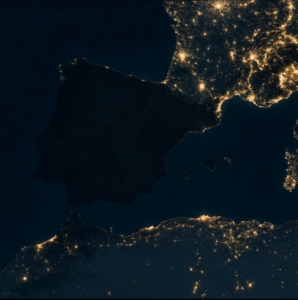
Satellite view of the Iberian Peninsula at night shows Spain and Portugal as mostly dark, with brightly lit France and coastal North Africa.
Digital Desert
Back at my accommodation, the implications of the blackout began to crystallise. My phone battery displayed an ominous 52% at only 3:00 PM. With no way to recharge, the countdown to digital isolation had begun. The precious device—typically just a convenience—had transformed into an essential lifeline, its remaining power requiring strategic rationing.
A simple need for bread turned into a 20-minute urban expedition, passing darkened storefronts and increasingly anxious faces. During this search, I overheard a delivery man sharing news gleaned from that suddenly precious technology—a battery-powered radio. “Es nacional,” he explained to a cluster of people. “Portugal también.” The scale became clear: this wasn’t a neighbourhood or city problem. Two entire countries had been unplugged from modern existence.
Outside banks, scenes reminiscent of historical economic crises unfolded as people formed desperate queues for ATMS that couldn’t dispense the suddenly precious commodity of cash. Those fortunate enough to have paper money in their wallets became the unexpected privileged class. At the same time, digital-only travellers found themselves suddenly penniless in a city that could no longer process electronic payments.
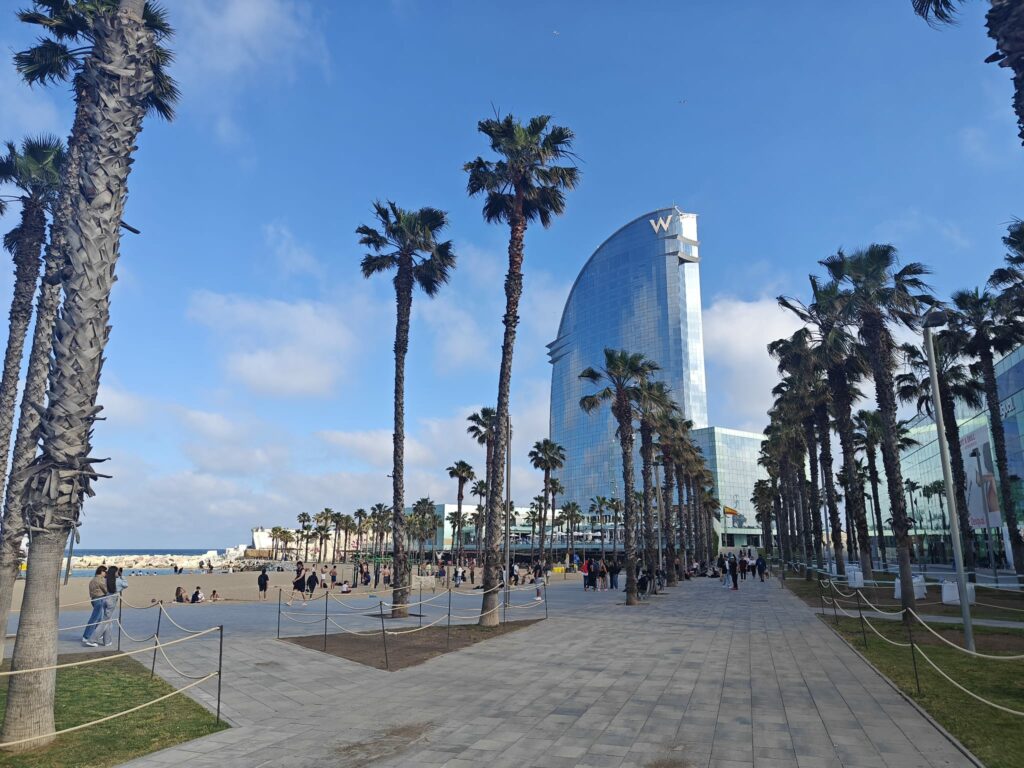
Palm trees line a walkway near a sandy beach bustling with people; a tall, sail-shaped glass building rises in the background, yes, the Hotel W —an iconic spot often featured in buying property in Spain guides and discussions on holiday rental Spain regulations.
The Economic Ripple
For local businesses, the financial impact was immediate and severe. Restaurants with gas stoves could still cook but struggled with inventory management and payments. Most closed their doors after serving whatever could be prepared without refrigeration. Tourism-dependent businesses—Barcelona’s economic lifeblood—suffered particularly, with tour operators, souvenir shops, and attractions forced to shut down entirely. Each hour of darkness translated to thousands of euros in lost revenue across the city, with small businesses lacking generator backup bearing the heaviest burden. The outage revealed the razor-thin margins many operated on, with a single day’s disruption threatening their financial stability.
Generation Disconnect
The crisis revealed a stark generational divide. Young people who had grown up immersed in digital ecosystems found themselves particularly disoriented. Their smartphones—useless without networks—had become mere glass paperweights. Once universal, the intuitive knowledge of navigating analogue systems had become a generational skill gap.
Meanwhile, older residents emerged as unexpected guides, remembering protocols from an era when digital convenience wasn’t assumed. They knew which stores might have manual processing capabilities, how to navigate by landmarks rather than GPS, and the importance of physical currency—insights suddenly invaluable in this temporary regression to pre-digital living.
Vertical Vulnerability
As evening approached, the building architecture itself revealed hidden vulnerabilities. Those living on higher floors of apartment buildings found themselves facing additional hardships. Without elevators, ninth-floor apartments became isolated islands requiring exhausting climbs. Water pressure failed in taller buildings as the pumping systems ceased operation. A simple rule emerged: the closer to the ground you lived, the more resilient your situation. First and second floors became the enviable locations in this new reality.
Residents of higher floors formed impromptu communities on ground levels, sharing resources and information rather than attempting the multiple climbs required throughout the day. Building lobbies transformed into command centres where neighbours who had never previously spoken coordinated water distribution and checked on vulnerable residents.
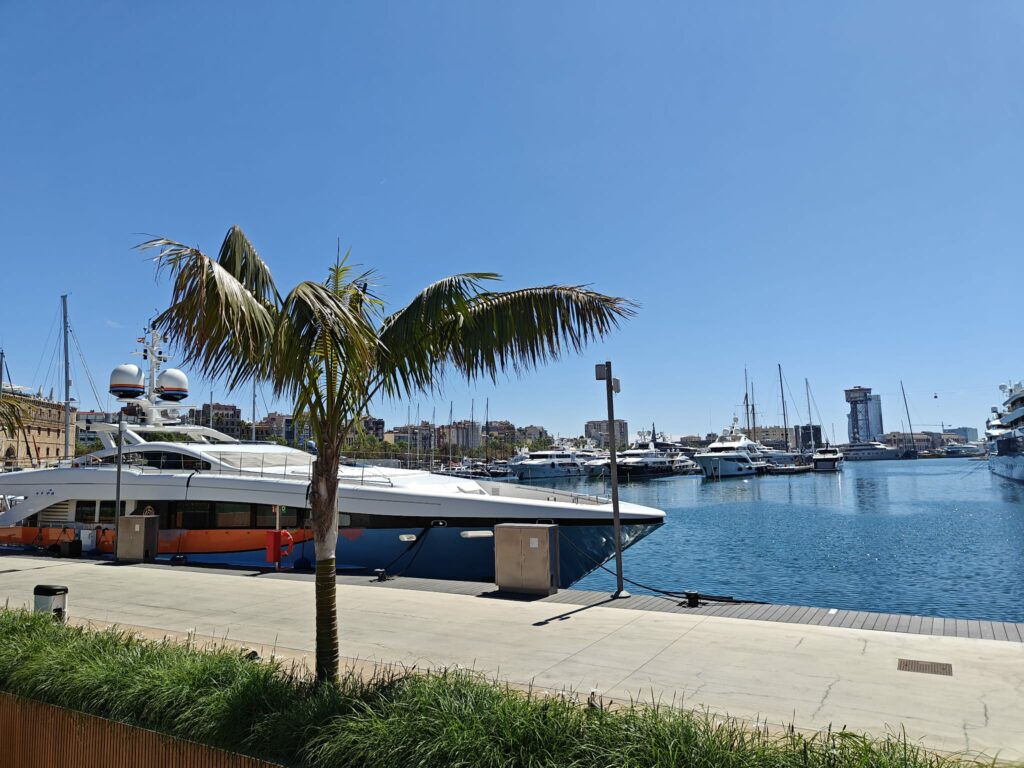
Barcelona’s marina with several yachts docked.
Locked Out in the Dark
Modern hotel security systems, entirely dependent on electricity, had transformed from conveniences into barriers. Electronic key cards became useless plastic as hotel door locks defaulted to their secure state. Travellers returned from daytime excursions to find themselves unable to access their rooms and belongings.
In a moment of foresight as night fell, I found myself in a peculiar negotiation with staff at a prominent French hotel chain, pleading for five minutes of their emergency power to charge my phone to 100%. The request, trivial on any typical day, had become a significant ask in this new reality. The charged device might be my only communication tool if the blackout extended into the next day.
Rumours circulated through darkened streets about when power might return. Would it be hours? Days? The authorities could only communicate through radio, reaching a fraction of the population. The rest of us navigated an information vacuum filled by speculation and growing concern. In the end, electricity would return around 2:00 AM, but during those 14 hours of darkness, Barcelona revealed vulnerabilities and strengths few had recognised before.
Official Response
The authorities’ reaction unfolded in stages, initially hampered by the same communication challenges affecting everyone. Within hours, Barcelona’s mayor appeared on emergency radio broadcasts, urging calm and announcing police deployment to major intersections and public areas. The Spanish electrical network authority, REE, issued statements confirming they were working to reconnect to the European grid. Regional emergency services prioritised hospitals and care facilities, dispatching fuel trucks to maintain generator operations.
Most notably, the municipal government quickly established information points at central plazas, staffed by officials with battery-powered megaphones sharing updates at regular intervals. The military was deployed to assist with traffic management and security at key infrastructure. Yet for many citizens, the official response seemed simultaneously impressive in its rapid mobilisation and inadequate against the scale of systems collapse, highlighting the limitations of disaster preparedness in an electricity-dependent society.
Vehicles Paralysed, Both Old and New
Would you like to watch this video in your language? Click on the bottom right of the video on “cc” to get subtitles in your language.
Transportation Chaos Across the City
The transportation ecosystem revealed surprising vulnerabilities. While fuel-powered vehicles initially seemed advantageous, gas stations couldn’t pump without electricity, creating new mobility limitations as tanks emptied. Even more striking was the complete immobilisation of electric vehicles—the supposed future of transportation. EVs stood abandoned in charging stations or parked along streets, their batteries holding a charge but their owners anxious about depleting their remaining range in a city where recharging had become impossible.
Urban mobility stratified into a hierarchy of resilience: bicycles and scooters became premium transportation, followed by vehicles with full fuel tanks, while electric cars—symbols of technological progress—ironically became the most vulnerable in this regression.
Radio Renaissance
As digital communication networks failed, a technological throwback emerged as the vital link to the outside world: radio. Those fortunate enough to own battery-powered radios became neighbourhood information hubs. Ingenious solutions appeared as people discovered that smartphone radio apps paired with wired earbuds could function as improvised antennas, transforming digital devices into analogue receivers.
Around these radio broadcasts, impromptu listening communities formed in plazas and cafés. For the first time in years, news consumption became a shared, communal experience rather than an isolated, individualised one. Normally consumed privately through personalised feeds, information is transformed into a public good shared through conversation.
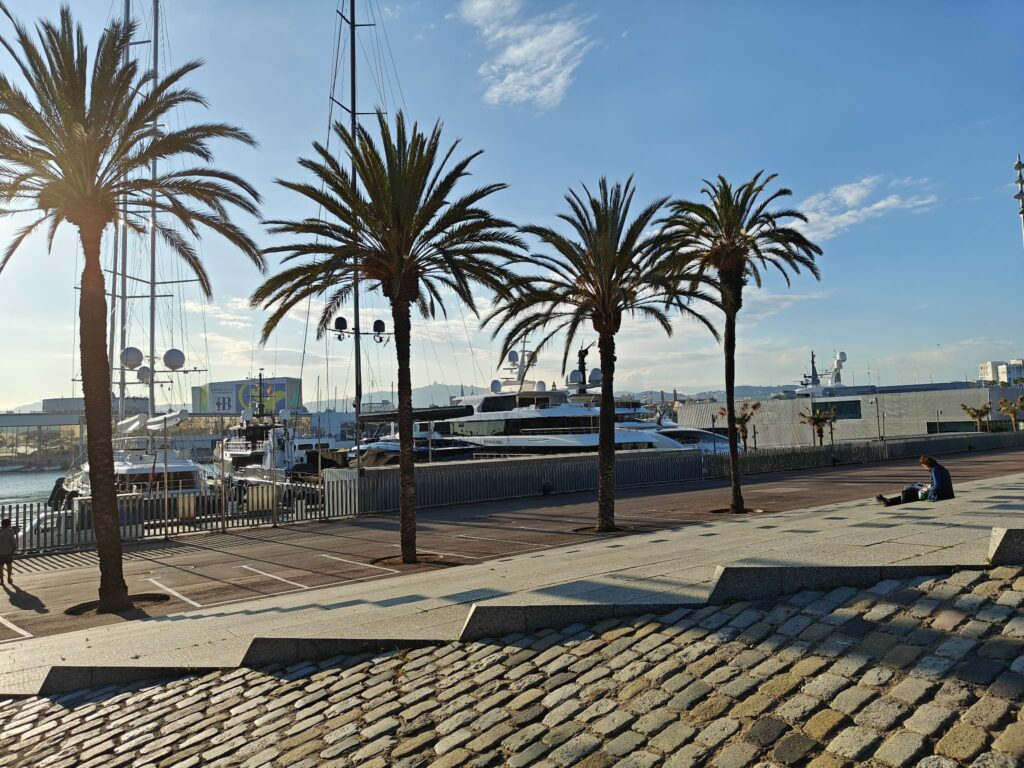
Palm trees line the marina walkway of Barcelona with yachts docked in the background.
The Infrastructure Lesson
As details emerged through radio reports, the magnitude of the system collapse became clear: in a mere five seconds, 15 gigawatts of power—equivalent to 60% of Spain’s electricity consumption at that moment—had suddenly vanished from the system. President Pedro Sánchez would later describe this as “something that never had happened before,” underscoring the unprecedented nature of the failure.
In the information vacuum created by the outage, theories about its cause began circulating. While officials initially remained cautious, avoiding speculation, several possible explanations emerged in the days that followed:
According to analysis from the Baker Institute, two consecutive generation failures likely occurred in large solar installations in southwestern Spain. This sudden loss of renewable capacity, combined with limited conventional generation backup and reduced support from neighbouring systems, created what energy experts termed a “perfect storm” for cascading failure.
Other experts pointed to power flux oscillation as the primary trigger. A strong energy flow fluctuation reportedly activated protective disconnects that severed Spain and Portugal from the European electrical grid, initiating the widespread collapse. This theory highlighted the vulnerability of interconnected systems, where a localised disruption can rapidly escalate to region-wide consequences.
The timing of the outage raised questions about Spain’s energy mix. With nuclear plants temporarily offline for maintenance, the grid heavily depended on renewable sources. Energy analyst Carlos Cagigal suggested that when these renewables—feeding already saturated substations—experienced a failure point, there wasn’t adequate conventional power generation to stabilize the system.
While cybersecurity experts from the European Union Agency for Cybersecurity indicated evidence of a technical cable fault rather than a malicious attack, government officials maintained that no hypothesis could be completely discarded during the investigation. This cautious approach reflected growing concerns about critical infrastructure vulnerability in an increasingly digitalised energy landscape.
More speculative theories also circulated, including the possibility of an unusual atmospheric phenomenon called “induced atmospheric vibration” affecting electrical infrastructure, though this received less support from official sources.
The event exposed the precarious nature of energy connections between the Iberian Peninsula and the rest of Europe. While hospitals maintained operations through backup generators, nearly everything else collapsed: businesses, railways, metros, elevators, traffic lights, and automated systems. The thin veneer of technological reliability had been stripped away, revealing the fragile interdependencies beneath.
In the aftermath, it became clear that modern electrical grids face a delicate balancing act—integrating more renewable energy while maintaining system stability. When disrupted, the blackout revealed how this balance can cascade through every aspect of contemporary life, from transportation to communication, commerce to healthcare.
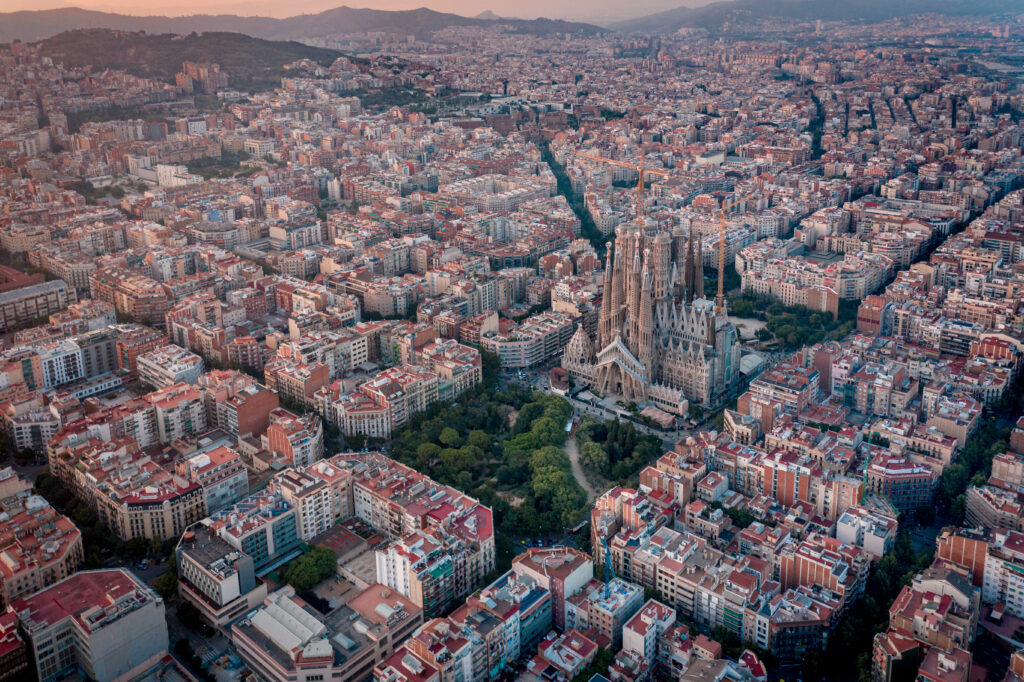
Barcelona City in Spain seem from the air, showing the impressive architecture and block systems of the apartments and offices in the busy Spanish metropolis
Human Current
What emerged most clearly was how electricity doesn’t just power our devices—it powers our social systems. Without it, the city’s rhythm changed dramatically. Restaurants with gas stoves became impromptu community centres, serving simple meals by candlelight until supplies ran out. The last loaves of bread disappeared from bakery shelves within hours.
Traffic intersections became four-way negotiations without signals to govern flow. Buses, packed beyond capacity, moved through streets with newfound caution as drivers navigated without electronic assistance. Inside these crowded vehicles, strangers exchanged information and theories rather than staring at separate screens—forced connectivity through disconnection.
Silver Linings in the Darkness
As night fell across Barcelona, unexpected positive societal shifts emerged. The streets were filled with people in unprecedented numbers for a Monday afternoon and evening. Without the pull of streaming services and digital entertainment, residents rediscovered the simple pleasure of promenading through public spaces. Conversations between strangers became commonplace rather than unusual.
The forced digital detox created space for direct human connection. Neighbours checked on elderly residents, bringing water and provisions. Communities self-organised to address immediate needs. For many, the evening without Netflix and digital distractions became a welcome reset—a reminder of slower rhythms and direct experiences that predated the digital age.
Most profoundly, the blackout triggered a collective awakening to the limits and fragility of systems often taken for granted. As darkness covered the city, a new light dawned in public consciousness about the vulnerability of our interconnected world and the resilience required to navigate its inevitable disruptions.
The Fragile Machine
As hours stretched into the night, the experience revealed the extraordinary complexity of systems we rarely consider. The invisible infrastructure that makes modern cities function—not just electricity but all the services it enables—became visible precisely because of its absence.
Sagrada Família, usually illuminated against the night sky, stood as a dark silhouette—perhaps closer to how Gaudí himself would have seen it. The architectural wonder, eternally under construction, seemed an apt metaphor for human progress: magnificent but incomplete, vulnerable to disruption.
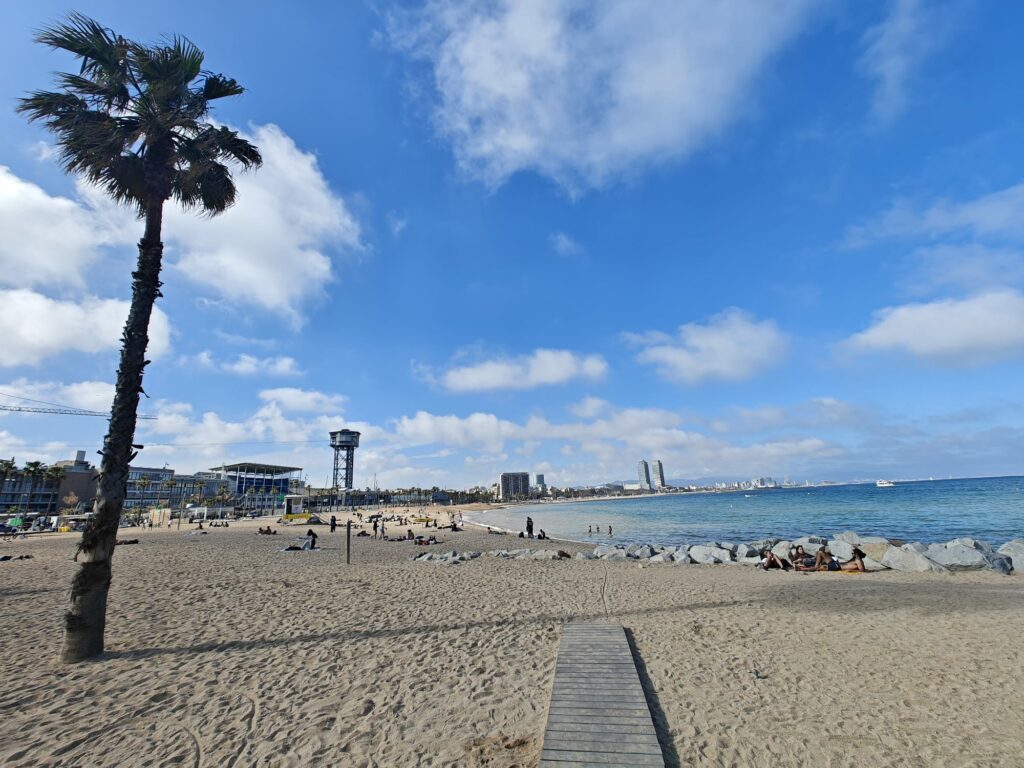
How to Survive the Great Unplugging
Should you find yourself caught in a significant power outage while travelling, these lessons from Barcelona’s experience might prove valuable:
Before It Happens:
- Carry sufficient cash in local currency—enough for at least two days
- Pack a portable phone charger/power bank and flashlight
- Download offline maps of your location
- Note key locations: the embassy, hospitals, and public gathering points
- Take photos of important documents (accessible even on a dead phone)
- When booking accommodations, prefer lower floors to avoid elevator dependency
When the Lights Go Out:
- Immediately conserve phone battery—use airplane mode and minimum brightness
- Secure water and non-perishable food quickly
- Stay put if it’s safe; unnecessary movement wastes resources
- If locked out of accommodations, find staff with manual override keys
- Remain vigilant about personal security in darkened areas
Communication Strategies:
- Use text messages instead of calls when networks are unstable
- Establish clear meeting points with companions rather than relying on calls
- Seek out radio information sources or use smartphone radio apps with wired earbuds
- Establish simple protocols for family members, including emergency contacts and meeting locations
- Turn on phones only at specific intervals to check for network restoration
Navigation and Transport:
- Orient yourself by landmarks rather than digital maps
- Use the stairs instead of waiting for the elevators
- Treat dark traffic signals as four-way stops
- Expect public transportation delays and overcrowding
- Consider walking for moderate distances rather than waiting for transport
Community Resources:
- Connect with fellow travellers and locals to share information
- Pool resources when possible
- Assist vulnerable people nearby
- Be patient with overwhelmed service workers
- Embrace the unexpected social connections that emerge during shared challenges
The power outage that transformed Barcelona revealed something essential: beneath our technological civilisation lies an older, more direct way of navigating the world. Those who adapted quickest could embrace this temporary step backwards as an adventure rather than merely an inconvenience.
Perhaps there’s something valuable in occasionally experiencing a city stripped of its digital layers—a Barcelona 3.0 that is, ironically, a return to version 1.0—where human connection and resourcefulness matter more than battery percentage and Wi-Fi strength.
Are you looking for a property lawyer in Spain? Follow the link and get one of our local lawyers. Looking for another real estate expert in Spain: Mortgage, Insurance, Survey of property, Property hunting, …? Contact one of our 100+ local partners!
Stéphane, Senior analyst and strategist at HTBIS
Stéphane, with over 20 years of experience in real estate, finance, and entrepreneurship, is the co-founder of www.howtobuyinspain.com. With an extensive network of local partners in Spain, his deep commitment to the real estate sector, strong analytical skills, and a problem-solving mentality have fueled his success. Constantly eager to learn and passionate about teaching, Stéphane believes in the power of knowledge-sharing to master any subject.

